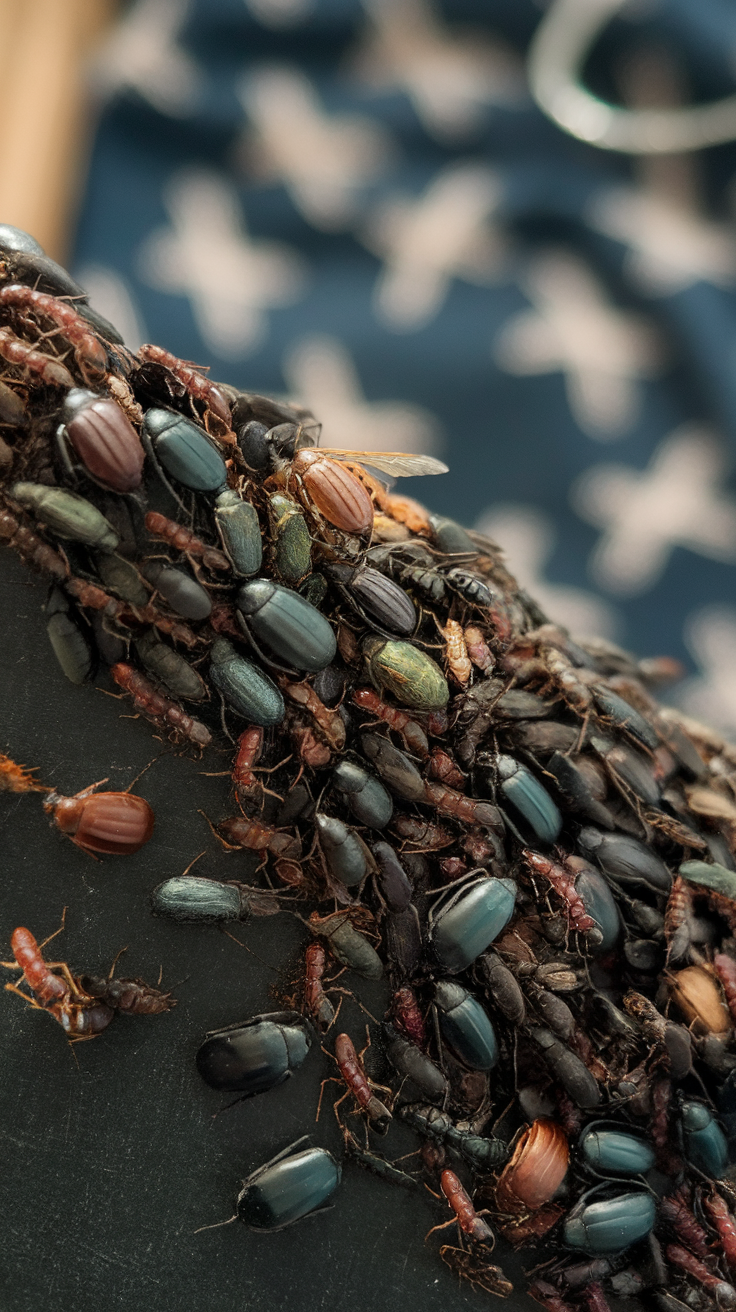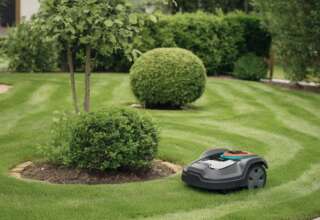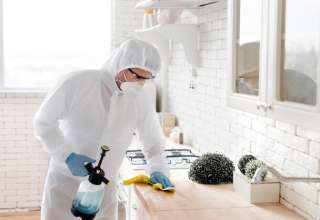What Attracts Pests
Pests don’t show up “just because.” They’re following cues, moisture, warmth, shelter, and easy calories. A dripping faucet signals a reliable water source. Cluttered storage areas (like basements or attics) create hidden nesting zones. And sometimes, you can even carry pests into your home yourself, bed bug exterminators often see cases where people unknowingly bring bed bugs back from hotels or vacation rentals. And crumbs, grease, or pet food? That’s a buffet. Even the smallest gap around a pipe or under a door can act as an open invitation, pests can sense the air exchange or smell from food indoors.
Many infestations start outside. Overgrown shrubs, compost piles, and uncovered trash cans create a safe basecamp for pests before they ever move indoors. These are common causes of pest infestations that can easily be fixed with small changes.
Pests are survival strategists: they’re drawn to stable environments with consistent warmth, moisture, and shelter. A home that stays around the same temperature all year and always has dark corners or steady humidity is a jackpot. Modern homes trap smells and warmth better than older ones, which means your HVAC system, dryer vent, or even pet bed can act as a year-round heat beacon for insects and rodents looking for predictability, not chaos.
Why Do Pests Come Into My Home?
A clean home isn’t the same as a pest-proof home. You can have spotless counters but still attract pests if you’re unknowingly offering moisture or warmth. Think of leaky pipes, damp basements, unsealed windows, or even the sweet scent from scented candles and dish soap, these all signal “habitable zone” to insects.
It’s not about dirt, it’s about opportunity. Most pest issues are driven by survival instincts, not filth. Even a tidy home can provide what they need: micro water sources, warmth, and darkness. A clean-looking space can still release microscopic food scents from drains, trash cans, or dish sponges. Ants can detect a crumb’s worth of sugar from several meters away, and roaches can survive on the glue from cardboard boxes or book bindings.
Many “cleaning” habits even backfire, like using citrus or floral cleaning sprays that mimic organic food scents to them.
Daily Habits That Attract Pests
Leaving pet food out overnight, even a few kibbles attract pests like roaches and rodents. Storing cereal or flour in open packaging or leaving a plate in the sink overnight gives pests an easy food source.
Ignoring minor plumbing leaks or keeping firewood, cardboard boxes, or reusable grocery bags near entry points provides moisture and shelter, especially in cluttered, dark corners.
Outdoor lights and air fresheners near doors can draw pests in by creating scent and light trails, while scented trash liners and candles signal “food nearby.”
It’s often not neglect, it’s routine convenience that sends the wrong signals.
Things That Attract Pests To House
Leaving pet food out overnight, even a few kibbles attract pests like roaches and rodents. Storing cereal or flour in open packaging or leaving a plate in the sink overnight gives pests an easy food source.
Ignoring minor plumbing leaks or keeping firewood, cardboard boxes, or reusable grocery bags near entry points provides moisture and shelter, especially in cluttered, dark corners.
Outdoor lights and air fresheners near doors can draw pests in by creating scent and light trails, while scented trash liners and candles signal “food nearby.”
It’s often not neglect, it’s routine convenience that sends the wrong signals.
Compost Without Attracting Pests
Composting only attract pests when it’s out of balance, too wet, too sugary, or too accessible. Use a sealed compost bin with a tight lid and a carbon filter, and keep the pile moist but not soggy, overly wet compost releases odors pests can smell from far away.
Avoid meat, dairy, or oily foods since they decompose slower and attract scavengers. Bury food scraps under dry browns like leaves or shredded paper to control smell and moisture. Add crushed eggshells or wood ash to neutralize odor and acidity, and toss in mint leaves or citrus peels as mild natural repellents.
If you compost outside, place the bin on hard ground or gravel to block burrowers and turn it regularly to keep it aerated. For urban composting, freeze scraps overnight first to stop odor release before adding them.
Compost done right actually repels pests, it breaks down fast, stays hot and active, and smells earthy, not like food.
Outdoor Habits That Cause Pest Issues Inside
Leaving pet bowls or bird feeders out overnight, overwatering plants, or ignoring clogged gutters all create ideal food and water sources for pests. Letting mulch or firewood touch exterior walls or stacking decor like planters or wood against them builds highways for ants and termites.
Keeping outdoor lights on near entry points draws insects, and spiders follow the buffet. Overdecorating the porch with mats, wreaths, and hanging plants adds nesting spots, while leaving outdoor furniture cushions out overnight combines warmth and moisture into perfect shelters.
Pests don’t “invade” from nowhere, they migrate gradually from the cozy outdoor setups we unknowingly design for them. Outdoor pest comfort always leads to indoor pest issues later.
Quick Fixes for Habits That Attract Pests
Wipe kitchen surfaces dry, moisture attracts more than crumbs. Store dry goods in sealed containers, empty trash cans nightly, and rinse recycling to cut off scent trails. Run your garbage disposal with ice cubes and lemon rinds to scrub odor-causing residue.
Add door sweeps, seal utility line gaps, and vacuum window sills and baseboards where crumbs and pheromones build up. Rotate indoor plants weekly so soil dries evenly.
Outside, use yellow or LED “bug lights” and motion-sensor lighting to break the constant attraction cycle.
These quick fixes dramatically reduce the scent and shelter cues pests rely on, tiny behavior tweaks beat harsh chemicals any day.
Early Signs of Pest Issues and Fast Fixes
Early warning signs include grease trails, droppings, shredded packaging, musty or “sweet” smells, webs near vents, or seeing the same ant or fly repeatedly in one spot.
You’ll know by patterns, not sightings. Fruit flies reappearing every few days mean organic waste is sitting too long. Ants showing up after cleaning? Your products might contain sugar alcohols or food-like fragrances. Roaches in one specific room? Check electronics or cardboard storage, not just the kitchen.
First fix: identify what they’re after, food, water, or shelter, and cut it off. If ants cluster under the sink, dry the area, seal cracks, and clean away even invisible residues. The key is to map the pattern, not panic-spray, follow the “why,” not just the “where.”
Simple Changes to Remove Causes of Pest Problems
Moisture control comes first, fix leaks, improve ventilation, and use dehumidifiers in basements. Stable humidity is key; most pests thrive at 60% and above, so monitor it with a hygrometer. These small changes eliminate major causes of pest problems before they grow.
Smart storage helps too: use glass or metal containers instead of cardboard or paper. Keep landscaping trimmed and dry, maintain gravel barriers near foundations and avoid mulch touching the house.
Seasonal checks and resets make a big difference: seal cracks before winter, inspect attic insulation yearly, and empty one storage area each season to disrupt nesting cycles.
Encourage biological allies like ladybugs, spiders, and certain wasps by avoiding broad chemical sprays outdoors. Run laundry or white noise machines in storage-heavy areas occasionally, pests avoid constant vibration zones.
Scent control matters more than surface cleaning, odorless spaces are pest-neutral spaces.
When your home ecosystem stays balanced, dry, and sealed, pests lose their survival edge entirely. True prevention isn’t cleanliness, it’s environmental disruption. Make your home unpredictable to them, and they move on.
FAQ: What Attract Pests
Why Do I Attract Bugs?
It’s less about you and more about your home’s ecosystem. Bugs sense imbalance, stale air, excess humidity, or unsealed entry points signal that nature can reclaim the space. Think of it as an environmental feedback loop, not a hygiene problem. Fix the balance, and the bugs move on.
Do Coffee Grounds Attract Pests?
They attract attention, not always pests. Fresh grounds’ aroma pulls in curious insects, but once decomposed, they act like compost, feeding soil microbes, not bugs. If pests appear, it’s usually from trapped moisture, not the coffee itself. Dry them out, and you’ll flip the signal from “dinner” to “deterrent.”
Does Cinnamon Attract Pests?
Only the curious human kind, not insects. Most bugs avoid cinnamon because it disrupts their scent trails. It’s not a magic fix, but it confuses their navigation system. So instead of chasing them off, you’re breaking their GPS.
Does Rosemary Attract Pests?
Rosemary’s scent repels most pests, but it can host them if it’s stressed. Aphids and spider mites target weak plants, not fragrant ones. Healthy rosemary is a natural air freshener; neglected rosemary becomes an insect Airbnb.
Does Mulch Attract Pests?
Mulch is like a hotel, it’s not the problem, it’s the five-star conditions beneath it. Warmth, cover, and consistent dampness attract pests of all kinds. Use coarse mulch and keep it dry, and you’ll turn that hotel into a “no vacancy” sign.












